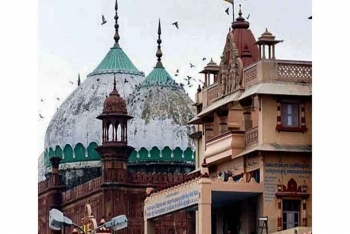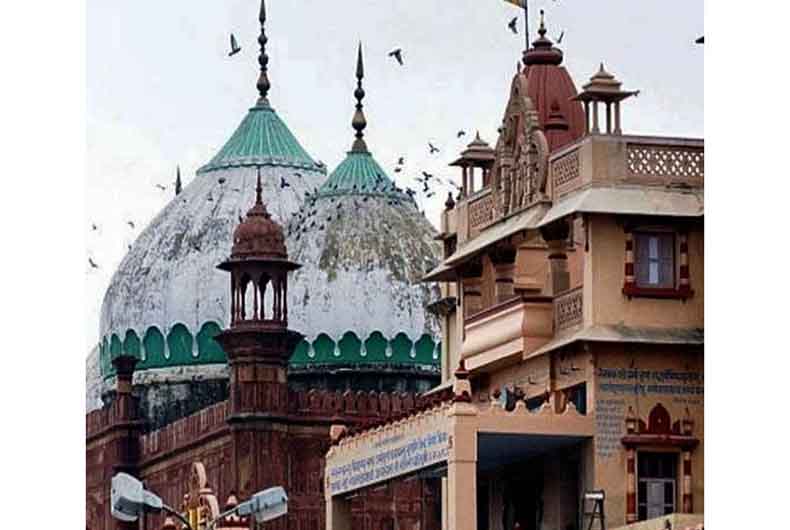
.png) Ram Puniyani
Ram Puniyani

The Uttar Pradesh elections are forthcoming in a few months. Many political analysts, with their ears to the ground, say that the popularity of the BJP and Modi-Yogi is on the downslide due to multiple hardships which average people had to face in recent times. The migration due to the pandemic, the farmers’ movement, the peaking of unemployment, the rising prices, and the abysmal state of healthcare seem to be pulling people out of the grip of communal polarization which has been inflicted upon them during the last couple of decades.
It is in this context that the tweets of Keshav Prasad Maurya, one of the Deputy Chief Ministers of UP, have to be seen. Boasting his government’s maintenance of law and order, he gave a divisive dog-whistle and tweeted that their administration has ensured freedom from crimes, abduction, and land occupation by lungiwalas with woven (Jalidar) caps, hinting at Muslims. He also tweeted that preparations of building grand temple at Ayodhya and Kashi are on and Mathura would be next.
While demolishing Babri Mosque, their slogan was that it was just a beginning; Kashi and Mathura would be next. This despite the Religious Places Act of 1991 that says there will be status quo in matters of places of worship, except Ayodhya which was under litigation at that time, as it was on 15th August 1947.
Temple-mosque issue has been one of the powerful weapons in the hands of BJP-RSS for electoral gains. They have practically demonstrated this through their Ram Temple campaign leading to Babri demolition and building of Ram Temple.
Even in case of Babri Mosque their claims were all made-up. The Supreme Court, despite many slips, did say that 1949 installation of Ram Lalla idols in the mosque and the demolition of Mosque in 1992 were crimes and that there was no evidence for a Ram Temple underneath the mosque; it also said that there was no proof to say Lord Ram was born precisely at that spot. But despite all these, Ram Temple campaign and Babri demolition yielded rich dividends for the divisive politics leading to the present assertive domination of the right wing politics in the country.
Temple destructions by Muslim Kings in the times gone by have been popularized through myriad mechanisms to make it a part of social common sense. Undoubtedly temples were destroyed by Muslims kings, but they were also destroyed by Hindu Kings. Somnath temple vandalism has been associated with Mahmud Gazni, but was it a religious matter or was it to plunder the wealth of the temple is a question in the realm of logic.
Kalhan’s Rajtaringini tells us about 11th Century King Harshdev who appointed a special officer to uproot the Gold-Silver-idols studded with pearls and diamonds. Wealth was the primary motive here. Richard Eaton, a prominent scholar, tells that many Hindu kings broke the idols of Kuldevtas of their rival kings. And even Aurangzeb was instrumental in destroying a mosque in Golconda when the local King Tanashah refused to pay tribute for many years.
All these are well documented in various historical documents. The British, to intensify their policy of ‘divide and rule’, selectively projected part of the picture to lay the foundation of hatred between Hindus and Muslims. Today resorting to logic and facts of the past is looked down upon.
Richard Eaton estimates that during Aurangzeb’s reign nearly 1-12 temples might have been desecrated on royal orders. Audrey Truschke, a historian, points out, “Political events incited Aurangzeb to initiate assaults on Hindu temples. For example Aurangzeb ordered demolition of Kashi Vishwanath temple (1669) and Mathura Krishna Dev Temple in 1670. In both instances Aurangzeb sought to punish political mis-steps by temple associates and ensure future submission to Mughal state.”
She further points out: “In 1670 he directed the obliteration of Krishna Dev Temple built in Mathura in 1618 by Bir Singh Bundela…for political reasons…Mathura’s Brahmins may have assisted 1666 escape of Shivaji from Agra.” Interestingly the same temple was patronized by Dara Shikoh.
The scientific study of events of history does tell us that kings were primarily ruling for power and wealth. The communal historiography, introduced by the British, associated kings primarily with their religion. And by this shrewd move the actions of Muslim kings were made to reflect upon the Muslims of the present. The deep propagation of these has led to the presently dominating social common sense, which associates temple destructions and conversions to Islam; to Muslim kings. With this there is long list of factors to demonize today’s Muslims. This demonization and hate is the ground on which communal violence-polarization stands and acts as a brake on the social amity.
Krishna Janmabhumi and Idgah abutting each other should be taken as a positive aspect of our culture. So far Hindus and Muslims of the area have been living with each other and greeting each other on each other’s festival. The present situation is a bit close to Mumbai’s traffic island. This one is in the central location in Mumbai, in Dadar. In the same island, touching each other are a temple and a mosque and a Church! Even in the worst phase of Mumbai violence of 1992-93, no one touched it. The followers of different religions look at it with great amount of reverence and love. Can we think of an India where such prevailing islands of amity are respected and upheld rather than erased on one or other pretext?